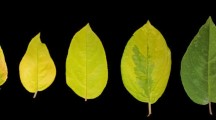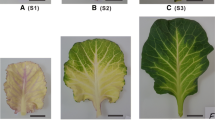Abstract
The leaves of the chrysanthemum variety ‘NAU04-1-31-1’ are variegated with distinct green and yellow sectors. The chlorophyll content of the yellow leaf tissue is less than that in the green one. The chloroplasts in the yellow leaf tissue were vacuolated, lacked thylakoid membrane structure and contained clusters of plastoglobuli with few or no starch grains. The yellow leaf tissue was more sensitive to photo-inhibition than the green leaf tissue. Suppression subtractive hybridization (SSHs) libraries were constructed to identify genes which were differentially transcribed in the two tissue types. The sequencing of 339 SSH clones identified 150 unigenes (93 singletons and 57 contigs), of which 85 were differentially transcribed in the green leaf tissue and 65 in the yellow leaf tissue. Unigenes associated with photosynthesis were particularly frequent, and many of these genes were up-regulated in the yellow leaf tissue. Both CmChlH which encodes the large subunit of Mg-chelatase and CmFtsH (ATP-dependent metalloprotease) were up-regulated in the yellow leaf tissue, and their transcription was regulated by light.










Similar content being viewed by others
References
Falbel, T. G., Meehl, J. B., & Staehelin, L. A. (1996). Severity of mutant phenotype in a series of chlorophyll-deficient wheat mutants depends on light intensity and the severity of the block in chlorophyll synthesis. Plant Physiology, 112, 821–832.
Killough, D. T., & Horlacher, W. R. (1933). The inheritance of virescent yellow and red plant colors in cotton. Genetics, 18, 329–333.
Wu, Z. M., Zhang, X., He, B., Diao, L. P., Sheng, S. L., Wang, J. L., et al. (2007). A chlorophyll-deficient rice mutant with impaired chlorophyllide esterification in chlorophyll biosynthesis. Plant Physiology, 145, 29–40.
Gustafsson, A. (1940). The mutation system of the chlorophyll apparatus. Lunds University Arsskrift, 36, 1–40.
He, B., Liu, L. L., Zhang, W. W., & Wan, J. M. (2006). Plant leaf color mutants. Plant Physiology Communications, 42, 1–8.
Guo, J. W., Guo, J. K., Zhao, Y., & Du, L. F. (2007). Changes of photosystem II electron transport in the chlorophyll-deficient oilseed rape mutant studied by chlorophyll fluorescence and thermoluminescence. Journal of Integrative Plant Biology, 49, 698–705.
Wang, H. Y., Hu, Y. H., Liu, Y., Zhou, Y. T., Wang, M. L., & Zhao, Y. (2008). Suppression subtractive hybridization identifies differentially expressed genes in Brassica napus chlorophyll-reduced mutant. Biologia Plantarum, 52, 486–492.
Masuda, T., Tanaka, A., & Melis, A. (2003). Chlorophyll antenna size adjustments by irradiance in Dunaliella salina involve coordinate regulation of chlorophyll a oxygenase (CAO) and Lhcb gene expression. Plant Molecular Biology, 51, 757–771.
Nagata, N., Tanaka, R., Satoh, S., & Tanaka, A. (2005). Identification of a vinyl reductase gene for chlorophyll synthesis in Arabidopsis thaliana and implications for the evolution of prochlorococcus species. Plant Cell, 17, 233–240.
Nakayashiki, T., Nishimura, K., & Inokuchi, H. (1995). Cloning and sequencing of a previously unidentified gene that is involved in the biosynthesis of haem in Escherichia coli. Gene, 153, 67–70.
Suzuki, J. Y., Bollivar, D. W., & Bauer, C. E. (1997). Genetic analysis of chlorophyll biosynthesis. Annual Review of Genetics, 31, 61–89.
Hudson, A., Carpenter, R., Doyle, S., & Coen, E. S. (1993). Olive: a key gene required for chlorophyll biosynthesis in Antirrhinum majus. EMBO Journal, 12, 3711–3719.
Jung, K. H., Hur, J., Ryu, C. H., Choi, Y., Chung, Y. Y., Miyao, A., et al. (2003). Characterization of a rice chlorophyll-deficient mutant using the T-DNA gene-trap system. Plant and Cell Physiology, 44, 463–472.
Sakamoto, W., Zaltsman, A., Adam, Z., & Takahashi, Y. (2003). Coordinated regulation and complex formation of yellow variegated1 and yellow variegated2, chloroplastic FtsH metalloproteases involved in the repair cycle of photosystem II in Arabidopsis thylakoid membranes. Plant Cell, 15, 2843–2855.
Takechi, K., Sodmergen, Murata, M., Motoyoshi, F., & Sakamoto, W. (2000). The YELLOW VARIEGATED (VAR2) locus encodes a homologue of FtsH, an ATP-dependent protease in Arabidopsis. Plant and Cell Physiology, 41, 1334–1346.
Degenhardt, J., Al-Masri, A. N., Kurkcuoglu, S., Szankowski, I., & Gau, A. E. (2005). Characterization by suppression subtractive hybridization of transcripts that are differentially expressed in leaves of apple scab-resistant and susceptible cultivars of Malus domestica. Molecular Genetics and Genomics, 273, 326–335.
Tsuwamoto, R., Fukuoka, H., & Takahata, Y. (2007). Identification and characterization of genes expressed in early embryogenesis from microspores of Brassica napus. Planta, 225, 641–652.
Xie, J. R., Liang, G. L., Tang, K. X., Zhang, H., Cheng, Z. Q., & Huang, X. Q. (2007). Construction and analyses of SSH cDNA libraries of rose foral color and scent mutant. Acta Horticulturae Sinica, 34, 688–694.
Hung, C. Y., Sun, Y. H., Chen, J. J., Darlington, D. E., Williams, A. L., Burkey, K. O., et al. (2010). Identification of a Mg-protoporphyrin IX monomethyl ester cyclase homologue, EaZIP, differentially expressed in variegated Epipremnum aureum ‘Golden Pothos’ is achieved through a unique method of comparative study using tissue regenerated plants. Journal of Experimental Botany, 61, 1483–1493.
Chen, S. M., Miao, H. B., Chen, F. D., Jiang, B. B., Lu, J. G., & Fang, W. M. (2009). Analysis of expressed sequence tags (ESTs) collected from the inflorescence of chrysanthemum. Plant Molecular Biology Reporter, 27, 503–510.
Zhang, L. J., & Fan, J. J. (2007). Plant physiology experiment course. Beijing: China Agricultural University Press.
Li, Z. L. (1996). Technology of plant production. Beijing: Peking University Press.
Sakamoto, W., Tamura, T., Hanba-Tomita, Y., & Murata, M. (2002). The VAR1 locus of Arabidopsis encodes a chloroplastic FtsH and is responsible for leaf variegation in the mutant alleles. Genes to Cells, 7, 769–780.
Diatchenko, L., Lau, Y. F., Campbell, A. P., Chenchik, A., Moqadam, F., Huang, B., et al. (1996). Suppression subtractive hybridization: a method for generating differentially regulated or tissue-specific cDNA probes and libraries. Proceedings of the National Academy of Sciences of the United States of America, 93, 6025–6030.
Ramakers, C., Ruijter, J. M., Deprez, R. H. L., & Moorman, A. F. M. (2003). Assumption-free analysis of quantitative real-time polymerase chain reaction (PCR) data. Neuroscience Letters, 339, 62–66.
Pfaffl, M. W. (2001). A new mathematical model for relative quantification in real-time RT-PCR. Nucleic Acids Research, 29, 2002–2007.
Ohmiya, A., Kishimoto, S., Aida, R., Yoshioka, S., & Sumitomo, K. (2006). Carotenoid cleavage dioxygenase (CmCCD4a) contributes to white color formation in chrysanthemum petals. Plant Physiology, 142, 1193–1201.
Zaltsman, A., Ori, N., & Adam, Z. (2005). Two types of FtsH protease subunits are required for chloroplast biogenesis and photosystem II repair in Arabidopsis. Plant Cell, 17, 2782–2790.
Bossmann, B., Knoetzel, J., & Jansson, S. (1997). Screening of chlorina mutants of barley (Hordeum vulgare L.) with antibodies against light-harvesting proteins of PS I and PS II: absence of specific antenna proteins. Photosynthesis Research, 52, 127–136.
Andersson, J., Wentworth, M., Walters, R. G., Howard, C. A., Ruban, A. V., Horton, P., et al. (2003). Absence of the Lhcb1 and Lhcb2 proteins of the light-harvesting complex of photosystem of the light-harvesting complex of photosystem II-effects on photosynthesis, grana stacking and fitness. Plant Journal, 35, 350–361.
Jiang, C. Z., & Rodermel, S. R. (1995). Regulation of photosynthesis during leaf development in RbcS antisense DNA mutants of tobacco. Plant Physiology, 107, 215–224.
Schoefs, B., Darkoa, E., & Rodermel, S. (2001). Photosynthetic pigments, photosynthesis and plastid ultrastructure in RbcS antisense DNA mutants of tobacco (Nicotiana tabacum). Zeitschrift fuer Naturforschung, C Biosciences, 56, 1067–1074.
Ifuku, K., Yamamoto, Y., Ono, T., Ishihara, S., & Sato, F. (2005). PsbP protein, but not PsbQ protein, is essential for the regulation and stabilization of photosystem II in higher plants. Plant Physiology, 139, 1175–1184.
Ihnatowicz, A., Pesaresi, P., Varotto, C., Richly, E., Schneider, A., Jahns, P., et al. (2004). Mutants for photosystem I subunit D of Arabidopsis thaliana: effects on photosynthesis, photosystem I stability and expression of nuclear genes for chloroplast functions. Plant Journal, 37, 839–852.
Andersson, J., Walters, R. G., Horton, P., & Jansson, S. (2001). Antisense inhibition of the photosynthetic antenna proteins CP29 and CP26: implications for the mechanism of protective energy dissipation. Plant Cell, 13, 1193–1204.
Bellemare, G., Bartlett, S. G., & Chua, N. H. (1982). Biosynthesis of chlorophyll a/b-binding polypeptides in wild type and the chlorina f2 mutant of barley. Journal of Biological Chemistry, 257, 7762–7767.
Molik, S., Karnauchov, I., Weidlich, C., Herrmann, R. G., & Kl sgen, R. B. (2001). The rieske Fe/S protein of the cytochromeb 6/f complex in chloroplasts. Journal of Biological Chemistry, 276, 42761–42766.
Shikanai, T. (2007). Cyclic electron transport around photosystem I: genetic approaches. Annual Review of Plant Biology, 58, 199–217.
Outchkourov, N. S., Peters, J., De Jong, J., Rademakers, W., & Jongsma, M. A. (2003). The promoter-terminator of chrysanthemum rbcS1 directs very high expression levels in plants. Planta, 216, 1003–1012.
Campoli, C., Caffarri, S., Svensson, J. T., Bassi, R., Stanca, A. M., Cattivelli, L., et al. (2009). Parallel pigment and transcriptomic analysis of four barley Albina and Xantha mutants reveals the complex network of the chloroplast-dependent metabolism. Plant Molecular Biology, 71, 173–191.
Leister, D. (2003). Chloroplast research in the genomic age. Trends in Genetics, 19, 47–56.
Murray, D. L., & Kohorn, B. D. (1991). Chloroplasts of Arabidopsis thaliana homozygous for the ch-1 locus lack chlorophyll b, lack stable LHCPII and have stacked thylakoids. Plant Molecular Biology, 16, 71–79.
Chekounova, E., Voronetskaya, V., Papenbrock, J., Grimm, B., & Beck, C. (2001). Characterization of Chlamydomonas mutants defective in the H subunit of Mg-chelatase. Molecular Genetics and Genomics, 266, 363–373.
Crouzet, J., Levy-Schil, S., Cameron, B., Cauchois, L., Rigault, S., Rouyez, M. C., et al. (1991). Nucleotide sequence and genetic analysis of a 13.1-kilobase-pair Pseudomonas denitrificans DNA fragment containing five cob genes and identification of structural genes encoding Cob (I) alamin adenosyltransferase, cobyric acid synthase, and bifunctional cobinamide kinase-cobinamide phosphate guanylyltransferase. Journal of Bacteriology, 173, 6074–6087.
Nakayama, M., Masuda, T., Bando, T., Yamagata, H., Ohta, H., & Takamiya, K. (1998). Cloning and expression of the soybean chlH gene encoding a subunit of Mg-chelatase and localization of the Mg2+ concentration-dependent chlH protein within the chloroplast. Plant and Cell Physiology, 39, 275–284.
Jensen, P. E., Petersen, B. L., Stummann, B. M., Henningsen, K. W., Willows, R. D., Vothknecht, U. C., et al. (1996). Structural genes for Mg-chelatase subunits in barley: xantha-f,-g and-h. Molecular and General Genetics, 250, 383–394.
Zhang, H. T., Li, J. J., Yoo, J. H., Yoo, S. C., Cho, S. H., Koh, H. J., et al. (2006). Rice Chlorina-1 and Chlorina-9 encode ChlD and ChlI subunits of Mg-chelatase, a key enzyme for chlorophyll synthesis and chloroplast development. Plant Molecular Biology, 62, 325–337.
Chen, M., Choi, Y. D., Voytas, D. F., & Rodermel, S. (2000). Mutations in the Arabidopsis VAR2 locus cause leaf variegation due to the loss of a chloroplast FtsH protease. Plant Journal, 22, 303–313.
Kakizaki, T., Matsumura, H., Nakayama, K., Che, F. S., Terauchi, R., & Inaba, T. (2009). Coordination of plastid protein import and nuclear gene expression by plastid-to-nucleus retrograde signaling. Plant Physiology, 151, 1339–1353.
Von Wettstein, D., Gough, S., & Kannangara, C. G. (1995). Chlorophyll biosynthesis. Plant Cell, 7, 1039–1057.
Sundberg, E., Slagter, J. G., Fridborg, I., Cleary, S. P., Robinson, C., & Coupland, G. (1997). ALBIN03, an Arabidopsis nuclear gene essential for chloroplast differentiation, encodes a chloroplast protein that shows homology to proteins present in bacterial membranes and yeast mitochondria. Plant Cell, 9, 717–730.
Acknowledgments
This work was supported by the National Natural Science Foundation of China (Grant No. 30872064, 31071820, 31071825), the Program for New Century Excellent Talents in University of Chinese Ministry of Education (Grant No. NCET-10-0492), Non-profit Industry Financial Program of the Ministry of Science and Technology of the People’s Republic of China (200903020) and the Fundamental Research Funds for the Central Universities (KYJ 200907, KYZ201112).
Author information
Authors and Affiliations
Corresponding author
Additional information
Qingshan Chang and Sumei Chen contributed equally to this work reported here.
Rights and permissions
About this article
Cite this article
Chang, Q., Chen, S., Chen, Y. et al. Anatomical and Physiological Differences and Differentially Expressed Genes Between the Green and Yellow Leaf Tissue in a Variegated Chrysanthemum Variety. Mol Biotechnol 54, 393–411 (2013). https://doi.org/10.1007/s12033-012-9578-8
Published:
Issue Date:
DOI: https://doi.org/10.1007/s12033-012-9578-8




